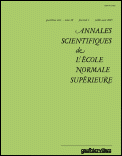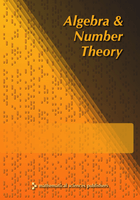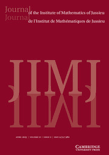
Documenta Mathematica
Scope & Guideline
Elevating Scholarly Discourse in Mathematics
Introduction
Aims and Scopes
- Algebraic Geometry and Algebraic Topology:
The journal features significant contributions to algebraic geometry, including the study of moduli spaces, Chow rings, and motivic cohomology, along with topological aspects of algebraic structures. - Representation Theory and Group Theory:
Research on representations of groups, particularly in relation to algebraic structures and their applications in number theory, is a core focus, including work on Galois representations and quantum groups. - Category Theory and Homological Algebra:
The journal often includes papers on category theory, derived categories, and homological properties, providing insights into the structural aspects of various mathematical frameworks. - Mathematical Physics:
There is a notable emphasis on mathematical physics, with papers exploring the interplay between mathematics and physical theories, particularly in areas such as quantum mechanics and statistical mechanics. - Number Theory and Arithmetic Geometry:
Papers addressing number theory, including Iwasawa theory, motives, and modular forms, reflect the journal's commitment to foundational aspects of mathematics and their interrelations. - Differential Geometry and Analysis:
The journal includes research on differential geometry, particularly focusing on geometric flows, curvature conditions, and their applications in geometric analysis.
Trending and Emerging
- Motivic Cohomology and Algebraic K-Theory:
There is a growing interest in motivic cohomology and its applications in algebraic K-theory, showcasing a trend towards exploring deeper connections between algebraic geometry and homotopical algebra. - Derived Categories and Homotopical Algebra:
Papers exploring derived categories, triangulated categories, and their applications in various mathematical contexts are increasingly prevalent, reflecting a shift towards more abstract and categorical methods. - Arithmetic Geometry and Galois Theory:
Research at the intersection of arithmetic geometry and Galois theory is on the rise, emphasizing the study of Galois representations and their implications for number theory. - Geometric Representation Theory:
Emerging themes in geometric representation theory, particularly related to quantum groups and their geometric realizations, indicate a growing interest in the interplay between geometry and representation theory. - Noncommutative Geometry:
The exploration of noncommutative geometry and its applications in various fields of mathematics and physics is gaining momentum, reflecting a trend towards innovative approaches to classical problems.
Declining or Waning
- Classical Real Analysis:
Research in classical real analysis seems to be less represented, with fewer papers focusing on traditional topics such as measure theory and functional analysis, indicating a shift towards more abstract and algebraic approaches. - Elementary Number Theory:
Papers that delve into elementary aspects of number theory, such as basic divisibility and prime number distribution, are becoming less common, possibly overshadowed by more sophisticated topics like arithmetic geometry. - Basic Combinatorial Structures:
There appears to be a decline in studies centered on basic combinatorial techniques and structures, as the journal's scope increasingly leans towards more complex algebraic and geometric frameworks. - Elementary Topology:
Research focusing on elementary topology concepts and problems is also on the decline, as more advanced topological theories gain traction in contemporary mathematical discourse.
Similar Journals

TRANSFORMATION GROUPS
Empowering Academics with Essential Research in Transformation GroupsTRANSFORMATION GROUPS, published by Springer Birkhäuser, is a leading academic journal specializing in the fields of algebra, geometry, and topology. With its ISSN 1083-4362 and E-ISSN 1531-586X, the journal has established itself as an essential resource for researchers and academicians, achieving a remarkable Impact Factor and ranking in prestigious categories: Q1 in Algebra and Number Theory and Q2 in Geometry and Topology as of 2023. Over its history from 1997 to 2024, TRANSFORMATION GROUPS has delivered cutting-edge research and innovative insights, currently holding Scopus rankings of #40/119 in Algebra and Number Theory and #38/106 in Geometry and Topology. This journal caters to those seeking to enhance their understanding of mathematical transformations and their applications, making it a vital platform for scholarly discourse within the mathematical community.

Cambridge Journal of Mathematics
Empowering Researchers with Cutting-Edge InsightsCambridge Journal of Mathematics, published by INT PRESS BOSTON, INC, is a premier platform for the dissemination of cutting-edge research in the field of mathematics. With an ISSN of 2168-0930 and E-ISSN 2168-0949, this journal stands out in a competitive academic landscape, currently ranked #58 out of 399 in General Mathematics, placing it in the top 15% within its category according to Scopus metrics. The journal serves as a vital resource for researchers, professionals, and students alike, aiming to foster groundbreaking mathematical inquiries and foster collaboration across disciplines. Published from 2020 to 2024, the Cambridge Journal of Mathematics is committed to maintaining high standards of scholarship, making it an essential read for those who are passionate about advancing mathematical knowledge and its applications.

ANNALES SCIENTIFIQUES DE L ECOLE NORMALE SUPERIEURE
Connecting Ideas, Inspiring Discoveries in MathematicsANNALES SCIENTIFIQUES DE L ECOLE NORMALE SUPERIEURE is a distinguished journal published by the Société Mathématique de France, dedicated to advancing the field of mathematics through high-quality research articles. With a robust impact factor and categorized as Q1 in Mathematics (Miscellaneous) as of 2023, this journal ranks in the top 16% of mathematics publications, showcasing its importance and influence in the discipline. Available in both print (ISSN: 0012-9593) and electronic formats (E-ISSN: 1873-2151), ANNALES SCIENTIFIQUES serves as a central hub for innovative mathematical theories and methodologies, appealing to a diverse audience of researchers, professionals, and students alike. The journal publishes research that spans various domains within mathematics, fostering a collaborative environment for idea exchange. As it converges from 1997 to 2024, it continues to shape the mathematical landscape, providing essential insights and developments within the global academic community. Located in Paris, France, the journal invites contributions that push boundaries and advance the understanding of complex mathematical concepts.

Algebra & Number Theory
Pioneering Research in Algebra and Number TheoryAlgebra & Number Theory, published by Mathematical Science Publications, stands at the forefront of mathematical research, particularly in the fields of algebra and number theory. With an ISSN of 1937-0652 and E-ISSN 1944-7833, this esteemed journal provides a dedicated platform for the dissemination of cutting-edge theoretical advances and practical applications. It has achieved a Q1 category ranking in both algebra and number theory according to the 2023 quartiles, reinforcing its critical role in shaping contemporary mathematical discourse. The journal serves as an essential resource for researchers, professionals, and students alike, offering insights into diverse mathematical methodologies and fostering open dialogue among scholars. Although it does not provide open access, its robust impact factor reflects the high quality and relevance of its published work. Based in the United States at the University of California, Berkeley, the journal's commitment to excellence continues to attract contributions that push the boundaries of mathematical understanding.

Selecta Mathematica-New Series
Elevating Mathematical and Physical Sciences.Selecta Mathematica-New Series is a premier academic journal published by Springer International Publishing AG, based in Switzerland. With an impressive impact in the fields of Mathematics and Physics, it is recognized in the Q1 category for both Mathematics (Miscellaneous) and Physics and Astronomy (Miscellaneous) as of 2023. Established in 1995, the journal provides a platform for rigorous peer-reviewed research, facilitating the dissemination of groundbreaking findings and theoretical advancements through its converged publication years up to 2024. Researchers and scholars seeking to stay at the forefront of mathematical and physical sciences will benefit from the journal's diverse scope and high-impact articles. Although it does not operate under an open-access model, Selecta Mathematica-New Series remains a vital resource for building knowledge and fostering collaboration among professionals and students engaged in these dynamic fields. Access to its content is essential for those aiming to deepen their understanding and contribute to the ongoing dialogue within the scientific community.

INTERNATIONAL JOURNAL OF MATHEMATICS
Bridging Ideas Across the Mathematical LandscapeInternational Journal of Mathematics, published by World Scientific Publishing Co Pte Ltd, is a leading academic journal dedicated to advancing research in the field of mathematics. With an ISSN of 0129-167X and an E-ISSN of 1793-6519, this journal provides a platform for the dissemination of high-quality mathematical research and fosters academic discourse among mathematicians and professionals worldwide. Operating out of Singapore, International Journal of Mathematics boasts a respectable Q2 ranking in the 2023 Mathematics (miscellaneous) category, indicating its commitment to impactful scholarship. The journal publishes articles that cover a broad spectrum of mathematical topics, ensuring valuable insights for researchers, educators, and students alike. Despite not being an open-access journal, it maintains accessibility through established university and institutional subscriptions, furthering its influence in the mathematical community. The journal has continually evolved since its inception in 1996 and will continue to be a crucial resource for insightful mathematical explorations until at least 2024.

Journal of the Institute of Mathematics of Jussieu
Advancing Mathematical Frontiers with Every PublicationJournal of the Institute of Mathematics of Jussieu, published by Cambridge University Press, is a leading academic journal that has established itself as a vital resource in the field of mathematics. With an impressive impact factor and a ranking in the top quartile (Q1) of miscellaneous mathematics, the journal serves as a platform for high-quality research from both established scholars and emerging researchers. Spanning from 2002 to 2024, the journal aims to foster collaboration and innovation in the mathematical community by publishing original research articles, reviews, and critical discussions on a wide range of mathematical topics. Although the journal does not offer open access, it remains widely accessible through various academic institutions and libraries, ensuring that critical advancements in mathematics are shared with a global audience. Located in the United Kingdom at the prestigious Cambridge campus, the journal reflects the rigorous standards of its publisher and the rich academic tradition of its home institution.

Epijournal de Geometrie Algebrique
Fostering Collaboration in Mathematical ResearchEpijournal de Geometrie Algebrique is an esteemed open-access journal dedicated to advancing the fields of Algebra and Number Theory, as well as Geometry and Topology. Published by the CENTRE COMMUNICATION SCIENTIFIQUE DIRECTE-CCSD in France, this journal has gained recognition for its commitment to disseminating high-quality research since its inception in 2017. With an impressive positioning in the prestigious Q1 quartile for both categories as of 2023, it occupies a notable space in the academic landscape. The journal aims to provide a platform for scholars to share innovative findings and foster collaborations within the mathematical community. Researchers, professionals, and students will find valuable resources, insights, and a vibrant forum for discussion in this journal, which reflects the dynamic evolution of algebraic and geometric studies. Access to all articles is freely available, ensuring that knowledge is accessible to a broader audience, thus promoting ongoing discourse and discovery in these critical branches of mathematics.

MANUSCRIPTA MATHEMATICA
Championing High-Quality Research in Mathematics.MANUSCRIPTA MATHEMATICA is an esteemed journal in the field of mathematics, published by Springer Heidelberg. Since its inception in 1969, this journal has served as a pivotal platform for disseminating high-quality research in a variety of mathematical disciplines, with a commitment to advancing knowledge and fostering collaboration among mathematicians. The journal holds a commendable impact factor and is ranked within the Q2 category for Mathematics (miscellaneous) in 2023, placing it favorably among its peers in terms of academic influence. Although open access options are not available, its rigorous peer-review process ensures that published articles maintain the highest academic standards. With a wide scope covering significant areas of general mathematics, MANUSCRIPTA MATHEMATICA not only caters to researchers and professionals seeking innovative insights but also serves as a valuable resource for students eager to deepen their understanding of mathematical theories and applications. For those looking to contribute to or stay informed about advancements in this dynamic field, the journal remains a crucial resource for literature and discourse.

TRANSACTIONS OF THE AMERICAN MATHEMATICAL SOCIETY
Pioneering Research in Applied and Theoretical MathematicsTRANSACTIONS OF THE AMERICAN MATHEMATICAL SOCIETY, published by the American Mathematical Society, is a premier journal in the field of mathematics that has been contributing to the advancement of mathematical knowledge since 1900. With an ISSN of 0002-9947 and an E-ISSN of 1088-6850, this journal holds a prestigious position in the academic landscape, evidenced by its Q1 rankings in both Applied Mathematics and Miscellaneous Mathematics categories as of 2023. With a Scopus ranking of #97 in General Mathematics and a percentile standing of 75th, the journal is recognized for its rigorous peer-review process and the quality of the research it publishes. Though it does not currently offer open access options, it essentially serves as a vital resource for researchers, professionals, and students seeking critical insights and developments in mathematical theory and applications. The Transactions aim to publish high-quality research articles that foster the exchange and dissemination of ideas, supporting the growth of both theoretical and applied mathematics within the global scholarly community.